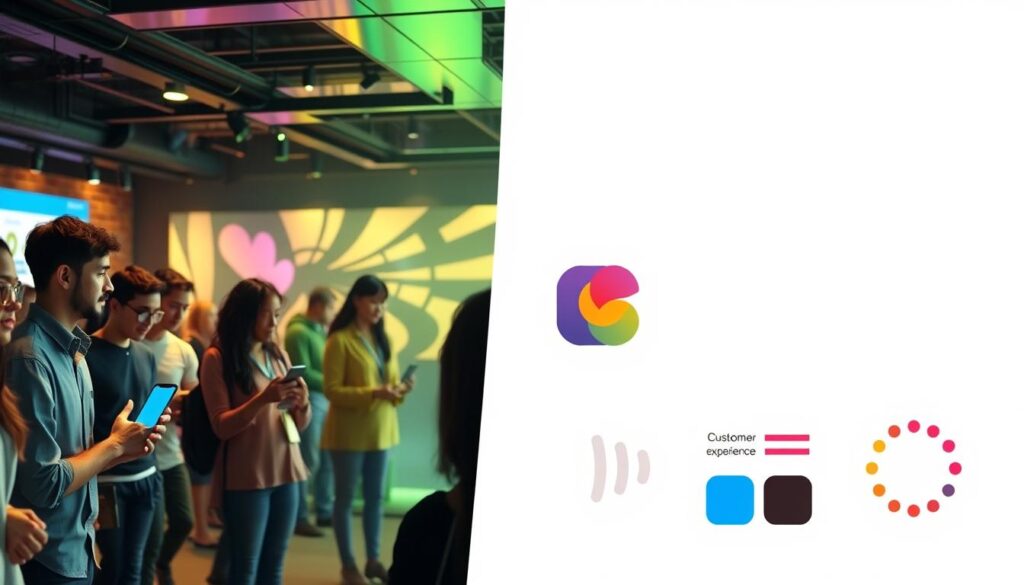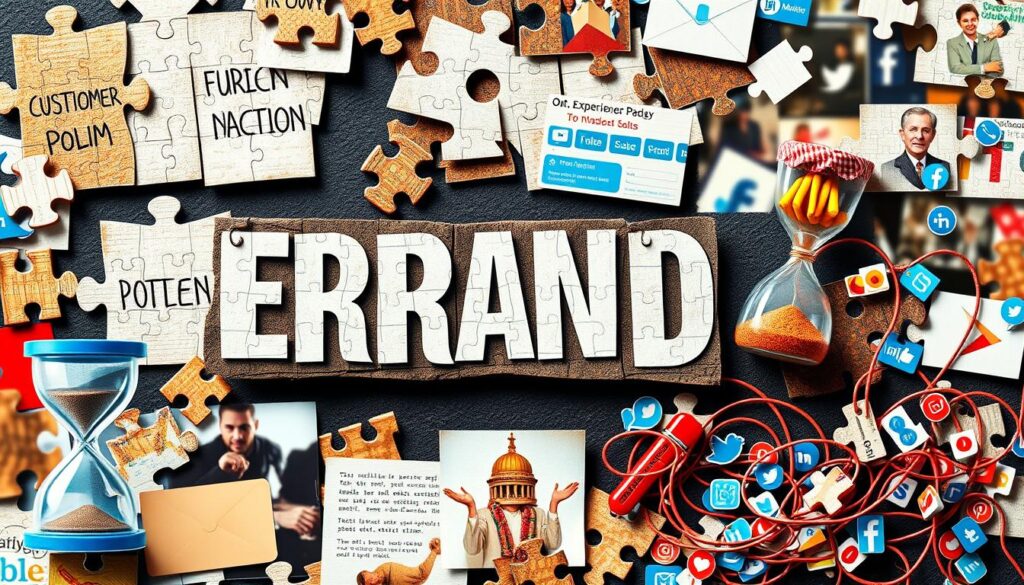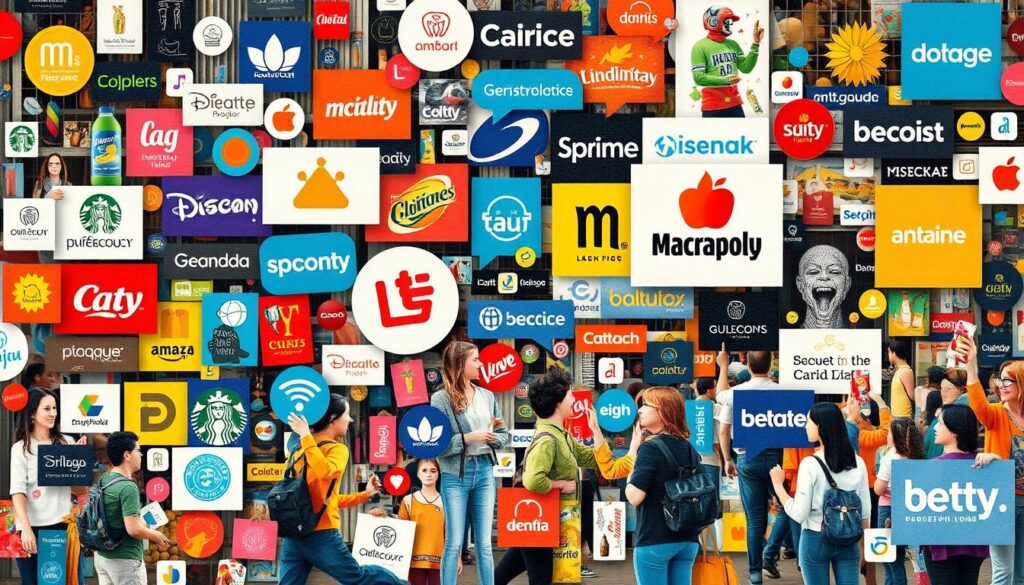What Is Brand Experience? Key Concepts Explained
In today’s business world, brand experience is key. But what is it, and why is it important for your business? Learn about the core elements of a memorable brand experience. See how they shape customer views and help your business grow over time.
Making a great brand experience is now essential, not just nice. Your brand’s ability to offer consistent, engaging, and emotional interactions is crucial. So, what makes the brands that create unforgettable experiences stand out?
Table of Contents
Key Takeaways
- Brand experience includes all interactions between a brand and its audience.
- Great brand experiences build loyalty and help your business grow in the long run.
- Creating a successful brand experience needs a strategic plan that fits your brand and customer needs.
- It’s important to connect digital and physical touchpoints for a complete brand experience.
- Always measure and improve your brand experience to stay competitive.
What Is Brand Experience: Definition and Core Elements
Brand experience is more than just a simple idea. It’s about all the ways a customer interacts with a brand. It’s how a customer feels about a brand after all their experiences.
Tangible vs Intangible Brand Experience Components
Brand experience has both physical and emotional parts. The physical parts are things like packaging and how a product works. The emotional parts are the feelings and values a brand gives off.
The Role of Sensory Marketing in Brand Experience
Sensory marketing is key in creating brand experience. It uses sight, sound, touch, smell, and taste to make experiences memorable. Good sensory marketing can make customers feel good and connect with the brand more.
Key Touchpoints in Brand Experience
- Product or service interactions
- Retail or digital environments
- Customer service and support
- Brand communications and marketing
- Social media and online presence
These touchpoints are all the ways a customer can interact with a brand. They are important in shaping how a customer feels and stays loyal to the brand.
| Tangible Brand Experience Components | Intangible Brand Experience Components |
|---|---|
| Product design and packaging | Brand personality and values |
| Retail environment and store layout | Emotional connections and brand loyalty |
| Product functionality and performance | Customer service and support |
| Digital interfaces and user experience | Brand reputation and trust |
The Evolution of Brand Experience in Modern Marketing
Marketing has changed a lot in recent years. The way brands connect with people has evolved. Now, it’s all about creating experiences that are immersive and use technology.
Before, marketing was mostly about one-way messages through ads and product placements. But, digital tech and social media have changed that. Now, people can interact with brands and influence how they’re seen.
- Brands aim to make experiences that feel real and connect with people on an emotional level.
- Using sights, sounds, and smells in marketing is becoming more common. It helps create deeper brand experiences.
- New tech like augmented and virtual reality is letting brands connect with people in new, exciting ways.
As marketing keeps changing, focusing on brand experience evolution is key. Brands that adapt to what customers want will do well in the future.
“The future of marketing lies in creating seamless, personalized brand experiences that captivate and inspire consumers at every touchpoint.”
By following modern marketing trends, brands can build stronger bonds with their audience. This leads to loyalty and support that goes beyond just ads.
Building Blocks of Successful Brand Experience Design
To create a memorable brand experience, you need a mix of key elements. At the core are visual identity and brand architecture. These set the tone and structure of your brand. Also, emotional connections are vital for building strong bonds with your audience.
Visual Identity and Brand Architecture
A strong visual identity is key to a memorable brand. Your logo, colors, typography, and images must all work together. Your brand architecture also plays a big role, organizing your offerings clearly and cohesively.
Emotional Connection Points
Great brand experiences touch on emotions, not just visuals. By finding and enhancing emotional touchpoints, you build lasting connections. This can mean telling compelling stories, improving sensory experiences, or creating a sense of community.
Digital Integration Strategies
In today’s world, blending online and offline channels is essential. This means optimizing your website, using social media, and adding interactive elements. The goal is to offer a consistent,
| Brand | Visual Identity | Emotional Connections | Digital Integration |
|---|---|---|---|
| Apple | Minimalist, sleek design, distinctive logo | Sense of innovation, creativity, and status | Seamless integration of hardware, software, and online services |
| Nike | Iconic “Swoosh” logo, bold color palette | Inspiration, motivation, and athletic performance | Immersive digital experiences, mobile app integration |
| Starbucks | Recognizable siren logo, warm, cozy aesthetic | Sense of community, relaxation, and indulgence | Seamless integration of in-store and mobile ordering |
These brands show how to design a great brand experience. They use their visual identity, emotional connections, and digital strategies. This creates memorable and engaging experiences for their customers.
How Brand Experience Differs from Brand Identity
Understanding the difference between brand experience and brand identity is key in branding. These two concepts are connected but serve different roles. They both affect how customers interact with a brand.
Brand Identity is about the visual and messaging parts of a brand. This includes logos, colors, fonts, and slogans. It’s how a brand looks and feels to the public.
Brand Experience is about everything a customer feels and does with a brand. It’s not just looks and messages. It’s the feelings and actions that come from interacting with a brand.

Brand identity is about how a brand looks. Brand experience is about how it feels. It’s the sum of all interactions, from first seeing the brand to after buying it. This shapes what customers think and feel about the brand.
“Brand experience is about the emotional connection and lasting impression a brand creates, while brand identity is the visual and messaging foundation that supports it.”
Managing both brand experience and identity is vital for businesses. It helps build lasting relationships with customers. When these two are in sync, a brand becomes memorable and meaningful to its audience.
Creating a Cohesive Brand Experience Strategy
To make a great brand experience strategy, you need a full plan. It should link your customer’s journey, blend experiences across different channels, and check how well your efforts work. This way, you can make a smooth and memorable brand experience that your audience will love.
Mapping Customer Journey Touchpoints
First, map out your customer’s journey. Find the key points where they meet your brand. These spots include your website, social media, in-store visits, and customer service chats. See how each point adds to the brand experience and aim for a consistent, positive feel at every step.
Integration Across Multiple Channels
In today’s world, your brand must be the same everywhere. Make sure your message, look, and customer interactions match on your website, mobile app, social media, and in person. This multi-channel integration is key for a strong brand experience strategy.
Measuring Brand Experience Success
Keep track of how well your brand experience strategy is doing. Look at things like customer happiness, loyalty, and how people talk about your brand. Use customer journey mapping to spot areas to get better and keep making your brand experience stand out.
By taking these steps, you can make a brand experience strategy that really connects with your customers. It will help build loyalty and grow your business.
The Impact of Digital Transformation on Brand Experiences
In today’s digital world, how brands interact with customers has changed a lot. Social media, mobile tech, and data analytics have changed the game. These changes have brought new chances and challenges for brands to make lasting connections with their audience.
Social media has been a big player in this shift. Sites like Facebook, Twitter, and Instagram are key for brands to talk to customers, share stories, and build communities. Brands can now quickly answer questions, get feedback, and even make content with their fans. This makes for a more lively and interactive brand experience.
Mobile technology has also changed how customers interact with brands. People using smartphones want easy, quick experiences, whether it’s finding product info or making purchases. Brands that get digital transformation can offer personalized, location-based experiences. These meet the needs of today’s mobile-first customers.
Data analytics is also key in shaping brand experiences. By using customer data, brands can understand what their audience likes and needs. This info helps brands improve their marketing and make the customer journey better across all touchpoints.
| Key Impacts of Digital Transformation on Brand Experiences | Examples |
|---|---|
| Social Media Engagement | Real-time customer interaction, user-generated content, community building |
| Mobile-first Experiences | Personalized, location-based experiences, seamless transactions |
| Data-driven Optimization | Tailored marketing, improved customer journey, enhanced personalization |
As digital transformation keeps changing the business world, brands that use these new tools will do well. They’ll be able to offer top-notch, branded customer experiences that meet today’s audience expectations.
Psychology Behind Successful Brand Experiences
Making a brand memorable is more than just looks or ads. It’s about understanding consumer psychology and how people see your brand. Knowing how emotional triggers affect customers is key to success.
Consumer Behavior and Brand Perception
People don’t just listen to ads. Their choices are shaped by many things, like their values and past experiences. By studying consumer psychology, brands can learn how their audience sees and interacts with them.
For example, research shows that people bond with brands that match their self-image. Creating a brand that truly connects with people builds trust and loyalty. This is crucial for a strong brand perception.
Emotional Triggers in Brand Experience
Great brand experiences touch emotions, not just inform. By using emotional triggers wisely, brands can make lasting impressions.
- Use nostalgia, wonder, or dreams to connect emotionally.
- Engage senses like sight, sound, and touch for a rich experience.
- Share stories that reflect customers’ lives, making them feel seen.
When brands hit the emotional mark, they win loyalty and advocacy. This leads to lasting success.
| Key Elements | Impact on Brand Experience |
|---|---|
| Consumer Psychology | Shapes customer decision-making and brand perception |
| Brand Perception | Influences emotional connection and loyalty to the brand |
| Emotional Triggers | Evoke powerful feelings and create memorable experiences |
Common Challenges in Brand Experience Management
Creating a smooth and consistent brand experience is tough for many companies. As marketing changes, businesses face many hurdles. These obstacles make it hard to give a unified and strong brand experience. Let’s look at some common brand experience challenges and how to manage them.
Siloed Organizational Structures
One big problem is when different parts of a company work alone. This can make the brand story disjointed and touchpoints uneven. To solve this, teams need to work together better and break down walls to share a single brand vision.
Technological Complexities
Digital tech is changing fast, adding complexity to managing brand experiences. It’s hard to link up different digital tools and systems. Companies need strong tech and smart plans to offer smooth experiences across all channels.
Shifting Consumer Expectations
Today’s shoppers want personal, seamless experiences. Keeping up with these changing needs is a big challenge. Brands must listen to customers, adjust their plans, and show they really get their audience to stay relevant.
To beat these brand experience challenges, companies need to be flexible, tech-savvy, and focused on the customer. With the right management strategies, brands can overcome these hurdles and give experiences that truly connect with their audience.

Future Trends in Brand Experience Design
Marketing and branding are changing fast. Brands need to keep up to offer amazing brand experience trends. Two big changes are AI personalization and immersive technologies.
AI and Personalization
Artificial Intelligence (AI) is making personal experiences possible like never before. Brands use customer data and AI to create experiences that fit each person’s needs. This way, brands can connect deeply with people and keep them loyal.
Immersive Technologies
Augmented reality (AR) and virtual reality (VR) are changing brand experiences. Brands are finding new ways to use these technologies, like virtual try-ons and immersive events. These experiences engage all senses and leave a strong impression on consumers.
Sustainability Integration
Sustainability is key in today’s brand experience trends. People want brands to be eco-friendly and socially responsible. Brands that focus on sustainability stand out and earn trust from eco-conscious consumers.
Brands that succeed will keep up with these brand experience trends. They will use AI personalization, immersive technologies, and focus on sustainability. This will make their brand experience stand out.
Conclusion
In this article, we’ve looked at how brand experience is key to building loyalty and growth. A good brand experience can deeply connect with your audience. It creates lasting bonds with your brand.
Understanding what makes a brand experience is crucial. It includes both physical and emotional aspects. By focusing on these, you can create experiences that truly connect with your customers.
Remember, brand experience is vital for your marketing strategy. Delivering consistent, engaging experiences can build strong customer loyalty. This will help your brand grow in today’s fast-changing market. Use brand experience to attract and keep your valued customers.
FAQ
What is brand experience?
What are the core elements of brand experience?
How has brand experience evolved in modern marketing?
What are the building blocks of successful brand experience design?
How does brand experience differ from brand identity?
What are the key steps in creating a cohesive brand experience strategy?
How has digital transformation impacted brand experiences?
What are the psychological factors behind successful brand experiences?
What are some common challenges in brand experience management?
What are the future trends in brand experience design?
Contact:
Website: www.huhuly.com
Email: [email protected]

